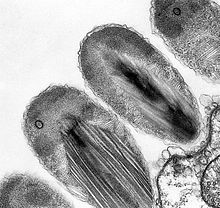Verrucomicrobiota
The phylum Verrucomicrobia is made up of six groups of gram-negative, spherical or rod-shaped bacteria that consume other plants or animals for energy and nutrients (heterotrophic). They are distributed throughout freshwater, marine, and soil habitats, as well as vertebrae digestive tracts including those of humans.[2] The bacteria within this group exist as a free-living organisms or symbiont (organisms that live in close physical association) with eukaryotic hosts from nematode worms and marine sponges to the gut of sea cucumber, clam worm, and humans.[3]
| Verrucomicrobiota | |
|---|---|

| |
| Transmission electron micrograph of stage II epixenosomes. | |
| Scientific classification | |
| Domain: | Bacteria |
| Superphylum: | PVC superphylum |
| Phylum: | Verrucomicrobiota Hedlund 2021[1] |
| Classes | |
| |
| Synonyms | |
| |
Planctobacteria Superphylum
changeMembers of the Verrucomicrobia phylum (group) are a part of the Planctobacteria (PVC) superphylum, along with its “sister groups”; Chlamydiae and Lentisphaerae.[4] Verrucomicrobia is distinguished from these other groups by a unique genetic change.
References
change- ↑ Oren A, Garrity GM (2021). "Valid publication of the names of forty-two phyla of prokaryotes". Int J Syst Evol Microbiol. 71 (10): 5056. doi:10.1099/ijsem.0.005056. PMID 34694987. S2CID 239887308.
- ↑ Bergmann, Gaddy T.; Bates, Scott T.; Eilers, Kathryn G.; Lauber, Christian L.; Caporaso, J. Gregory; Walters, William A.; Knight, Rob; Fierer, Noah (2011-07-01). "The under-recognized dominance of Verrucomicrobia in soil bacterial communities". Soil Biology and Biochemistry. 43 (7): 1450–1455. doi:10.1016/j.soilbio.2011.03.012. ISSN 0038-0717. PMC 3260529. PMID 22267877.
- ↑ Cardman, Z.; Arnosti, C.; Durbin, A.; Ziervogel, K.; Cox, C.; Steen, A. D.; Teske, A. (2014-06-15). Spormann, A. M. (ed.). "Verrucomicrobia Are Candidates for Polysaccharide-Degrading Bacterioplankton in an Arctic Fjord of Svalbard". Applied and Environmental Microbiology. 80 (12): 3749–3756. doi:10.1128/AEM.00899-14. ISSN 0099-2240. PMC 4054139. PMID 24727271.
- ↑ Cho, Jang-Cheon; Vergin, Kevin L.; Morris, Robert M.; Giovannoni, Stephen J. (June 2004). "Lentisphaera araneosa gen. nov., sp. nov, a transparent exopolymer producing marine bacterium, and the description of a novel bacterial phylum, Lentisphaerae". Environmental Microbiology. 6 (6): 611–621. doi:10.1111/j.1462-2920.2004.00614.x. ISSN 1462-2912. PMID 15142250.